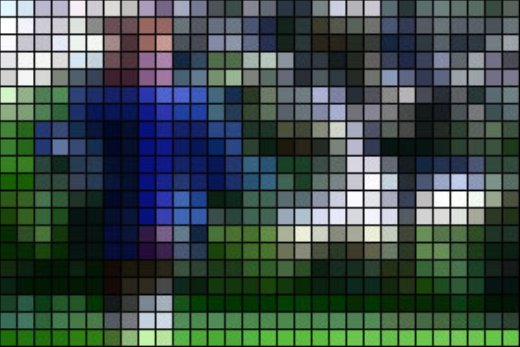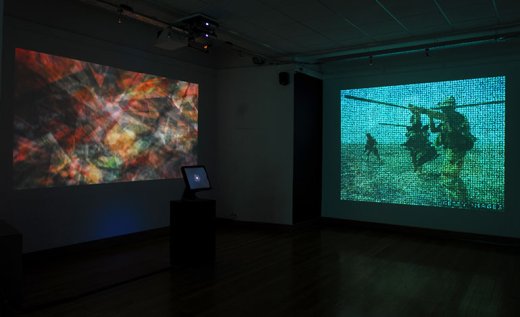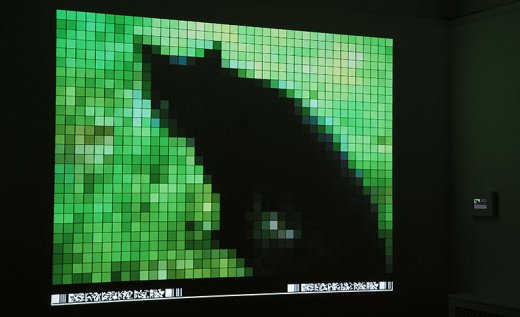



Addressable Memory
Touring exhibition by Michael Takeo Magruder
TheSpace4, Peterborough, 22nd September – 18th November 2007
Andy Warhol’s audio cassette tape recorder was his constant companion and confidant. He used to call it his wife. Many of Warhol’s tapes were of nothing other than white noise and the occasional sudden background sound. Warhol also carried a Polaroid camera, shooting tens of thousands of photographs over the last decades of his life. His obsessive recording of the minutiae of his existence must have appeared eccentric in the second half of the Twentieth Century.
Traditionally the technology of mechanical recording and reproduction of sound and image has been the resource of mass media, of news media. News is the first draft of history. It is the sensorium of shared memory, dominated by a few powerful centralized voices. A lone artist such as Warhol could not reproduce the workings of the mass media no matter how hard he tried. He could however allegorize and represent it.

The analogue technology that Warhol used has given way to digital audio and video. High-definition, high dynamic contrast range chips are now included on even relatively cheap mobile phones. Warhol’s two devices have become one. Anyone can record dozens of images and many minutes of sound or video each day if they want to. With broadcast distribution giving way to the more decentralized distribution system of the Internet they can share their personal media with friends around the world instantly or even with the entire on-line world via sharing sites. In the twenty-first century Warhol would just be a mid-volume user of Blogger and Flickr.
Personal digital technology and the publishing medium of the Internet blur any line between personal and shared memory, and between experience and representation. This may be experienced as empowered citizen journalism, the future embarrassments of youthful digital exhibitionism, or the spectre of a participatory surveillance society.
Michael Takeo Magruder is portraying this landscape of digital memory with its own tools, producing portraits of its inhabitants with its own palettes. In Addressable Memory the first draft of history is allegorized as a process of combining and quantizing disparate experience and telemetry. Of mashing-up and composing. The technology and aesthetics of mobile phones, Internet news feeds, video screens, computer image processing and virtual reality are all turned on themselves. At TheSpace4 in Peterborough this show takes up all three rooms. It will be touring the UK throughout 2008.

The first room contains large scale prints and projections of pixellated camera phone images and video along with smaller images on camera phone screens. Even the placards next to each work are small video screens, emphasizing the feeling of the pervasiveness of digital media.
Pixels are an established enough visual form now that they have a certain cultural resonance and are a part of everyday experience. They are ephemeral and functional grids of colour, quite the opposite of the carefully considered coloured grids of abstract high art.
The large-scale prints and projections abstract and compose the pixellated images to the point where this opposition collapses. Mondrian’s Broadway Boogie Woogie performed a similar but more celebratory synthesis of media overload and contemplative reflection combining urban architecture and mass mediatized music with the modernist abstracting grid in the analogue age of mass media.
Phone images and video clips are fragmentary records of life in a visually saturated corporate information culture. Recasting them in the visual language of high art’s slow contemplation affords the viewer a different, less commodified and commodifying way of looking at the representations of this culture. The critical aesthetic engagement of the work is one that the viewer can share and take with them when they leave the gallery if they wish.
The middle room has generative art prints on its walls created by software that produces compositions from reprocessed digital imagery. Strangely this seems the most visually and technically traditional work in the show. Surrounded by this, on the central platform a hardware based piece presents the hardware and software of handheld sound and image as a microcosm both of the social and media networks of digital media. In a wirelessly networked age the wiring under the board is in the air between devices, the analogue video artist’s shtick of taking the casing off of televisions wouldn’t show how this system works. This is a transition from the personal imagery of the first room to the mediatized imagery of the third room.
The third room is dark but lit by the projections, screens and monitor banks of works that remix the visual, audio and textual representations of reality created by the mass media. The loud, bright, pervasive, confident voice of the mass-media is reimposed on itself. Letters become pixels that images are rendered into, web sites are projected onto virtual reality geometry, striking news imagery is broken down across grids of monitors or at different speeds.
This is a redoubling of the experience of broadcast media. The media selectively quantizes, re-maps and filters reality before presenting its representations as added value. Here this process is applied back to the representations produced by the media and thereby to the media itself. This is a mapping of media’s hyperspace back onto itself.

Such recursion is the stuff not just of memory but of awareness, the start of a strange loop (pace Douglas Hofstadter) that comes to know itself through repeated introspection. The machinery and techniques of mediatization turn unique experience into fungible data. The works in the third room of “Addressable Memory” reverse this process by continuing and intensifying it.
Addressable Memory as a whole steps back from a world pervaded by the representational machinery of digital media that reduces both personal and shared experience to economically leveragable ephemeral information in order to pause and reflect on it. It re-presents the representations of the personal and institutional products of this machinery in a more contemplative and more contextualising way, intensifying the use of technology to the point where the presence of that pervasive technology is again visible but the content and operation of that technology is defamiliarised and contemplatable. This is a coherent and mature body of art that works with the viewer to produce a revealing portrait of their visual environment.
http://www.takeo.org/
This work is licensed under a Creative Commons Attribution-Share Alike 3.0 License.